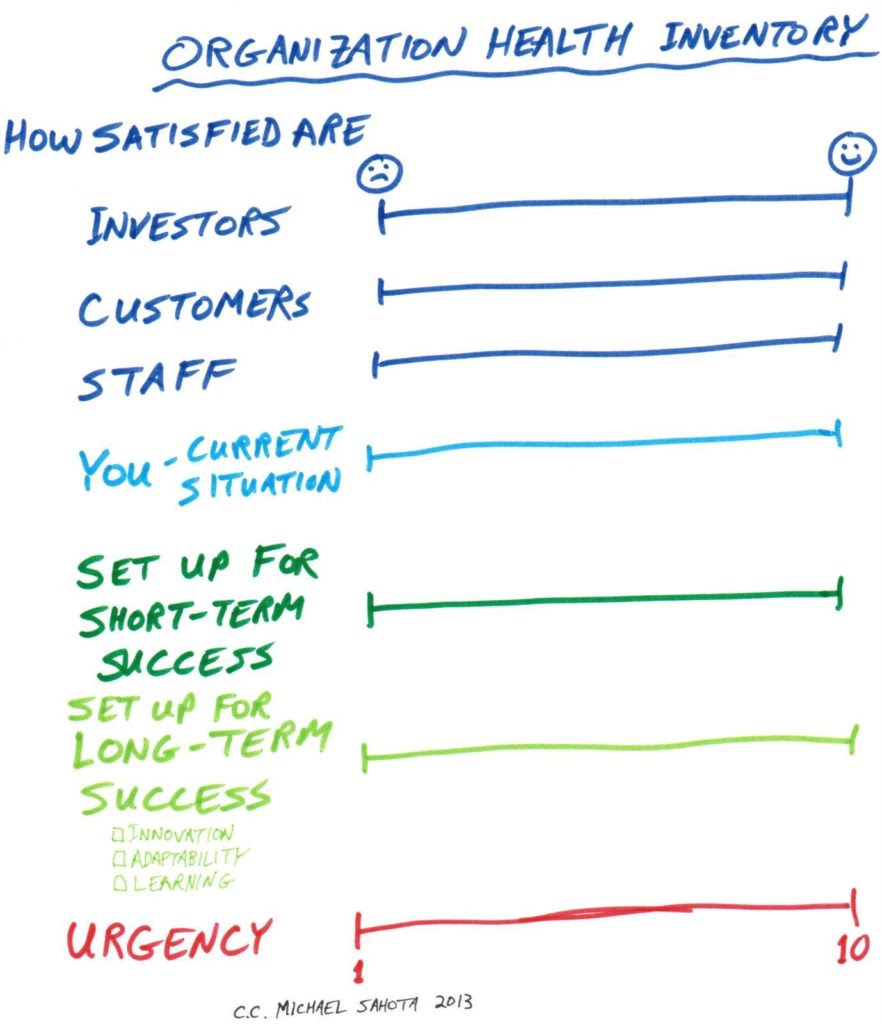Abstract
Many organizations are interested in transforming their organizations using Agile and other initiatives to get breakthrough results. Although there is a great deal of desire for the benefits, the level of investment and focus in many organizations often falls short of the mark. We share a checklist and diagnostics that can be used at the outset to understand the level of investment in organizational transformation. This can be used to provide sustainable energy for the transformation effort or identify the need to scale back efforts to something less ambitious so that some benefits can be realized.
In the past few years, it has become increasingly clear that there is a world of difference between the adoption of Agile practices and the transformation to an Agile mindset or culture [Sah12][May13]. Adopting Agile practices focuses on modest process improvements that do not disrupt the organizational system. At the other extreme, transformation fundamentally alters the nature of the company – a paradigm shift.
This article focuses on understanding the readiness of the leadership to undertake organizational transformation. One example of transformation is the pursuit of upgrading or rebooting the cultural operating system of the company. We share a checklist and diagnostic tool to understand current perceptions.
In his seminal work, John Kotter identifies a Sense of Urgency as the key first step to any major change initiative [Kot12]. Success requires that “75% of a company’s management is honestly convinced that business as usual is totally unacceptable.”
Let us now turn our attention to considering some additional diagnostics to facilitate a conversation with executives about the level of energy available for transformation.
Test: Is Transformation the #1 Organizational Priority?
Transformation requires an incredible amount of sustained energy to execute. If transformation is not the #1 organizational priority, then the effort will fail for sure. I have even seen adoption efforts (not even transformation) fail when they are lower in priority than other initiatives. For example, at one large organization I visited, Agile was #4 on the priority list and there was no sense of urgency. After a period of struggling there was a complete rollback of the Agile initiative. Don’t let this happen at your organization. If transformation isn’t your #1 priority, save your time, energy, and money for some other activity.
Perhaps the most substantial measure is how much effort is the leadership investing in the transformation. Although money and full-time staff are essential, transformation efforts will fail unless leaders actually lead the organization and model the change that they want to see.
The most common scenario for raising this level of energy is an extinction threat to the organization or inspired leadership for a radically better future.
Leadership Team Readiness Checklist
I use this checklist to assess whether the leadership in an organization really wants transformation.
- Confront the Red Flags? The ability of leadership to identify and confront the difficult truths (red flags) was identified as the key to success. [Col01] Some activities that help illuminate this are interviews, retrospectives, examining culture, and Gemba walks.
- Visionary? Does the leadership have the seeds of greatness to wish for an inspired future? Some activities that support this include workshops around vision and identity; socializing possibilities by examining other breakthrough organizations as well as leadership retreats such as Temenos Lab.
- Willingness to Act. “Red Pill” vs. “Blue Pill”? Red Pill is a term from the movie The Matrix that denotes the willingness to explore disconnects in our belief system to understand the true and perhaps discomforting reality. Blue Pill takes you back to your everyday comforting reality and erases all thoughts of trouble and concern. Do leaders have the ability and willingness to act based on their new reality?
How is your Organization Doing?
The following set of diagnostics can start a real discussion around the perception of the current state of the organization. This will cut right to the heart of the matter to explore the leadership team’s perception of “red flags” and will give first-hand data about their interest in taking a red or a blue pill.
For each of the metrics listed below, we would like to capture the response of each member of the leadership team. This could be done individually via a handout with aggregate results shown on a whiteboard or flipchart. Alternatively, each member of the team could place initials or a mark on a line to show their sense of where things are in the organization.
The scale for each metric increases from left to right with either a rating of 1 to 10 or from ☹☹ to ☺☺:
The metrics are:
- How satisfied are:
- Customers?
- Staff?
- Investors?
- How satisfied are you with the current situation?
- Set up for short-term success?
- Set up for long-term success (adaptability, innovation)?
- Urgency around transformation?
The diagram below illustrates how these questions may appear on a handout or flipchart.

My Worst Nightmare
A completely different way of running a workshop with a leadership team is to use the Innovation Game® “My Worst Nightmare”. It provides a creative way to tap into challenges and fears of the future [Hoh11].
Acknowledgments
A portion of this work was generated together with Don Gray and Claudia Melo. Don also helped refine this article. I would also like to acknowledge the financial contribution of the Agile Alliance for sponsoring the event through the Supporting Agile Adoption Program.
References
[Col01] Jim Collins, “Good to Great: Why Some Companies Make the Leap… and Others Don’t”
[Hoh11] Luke Hohmann, “My Worst Nightmare: Discover Hidden and/or Unconsidered Worst-Case Scenarios”
[Kot12] John Kotter, “Leading Change”
[May13] Tobias Mayer, “The People’s Scrum: Agile Ideas for Revolutionary Transformation”
[Sah12] Michael Sahota, “An Agile Adoption and Transformation Survival Guide: Working with Organizational Culture”
[Sah13] Michael Sahota, Organizational Transformation Checklist (Original Post): http://agilitrix.com/2013/05/organizational-transformation-checklist/










